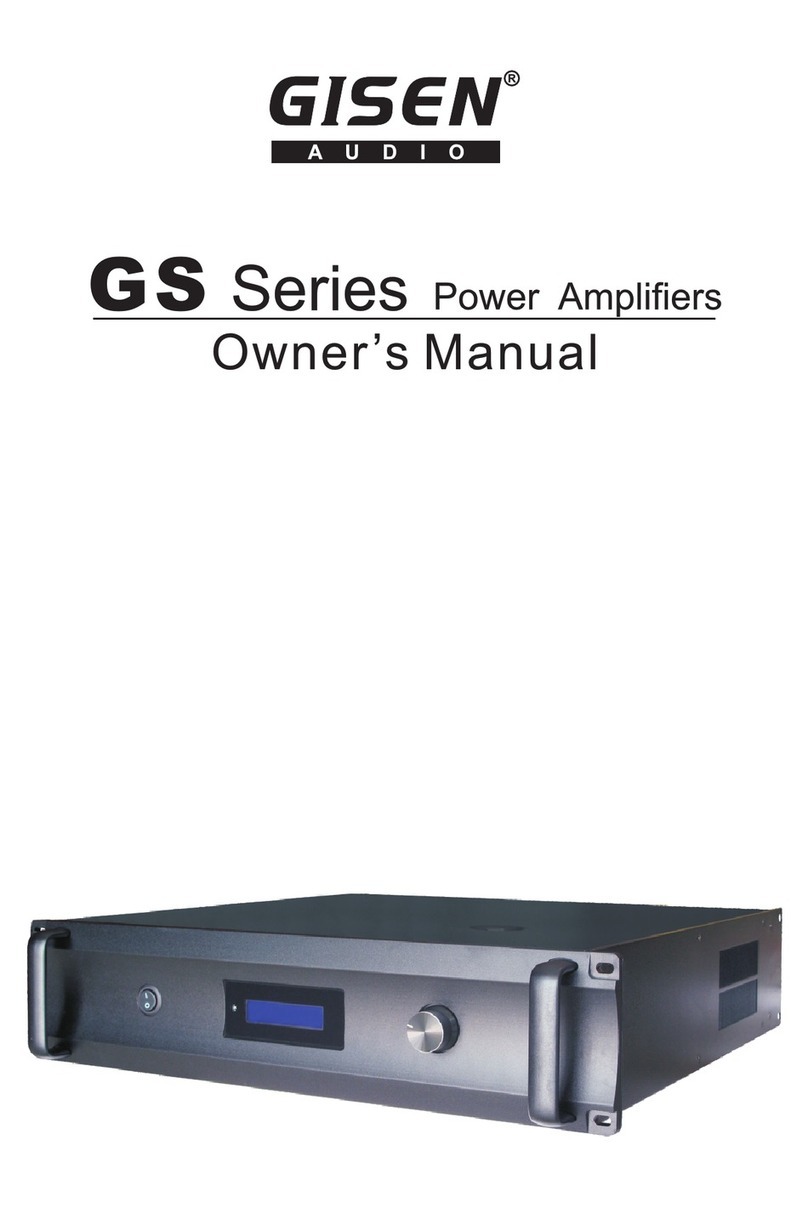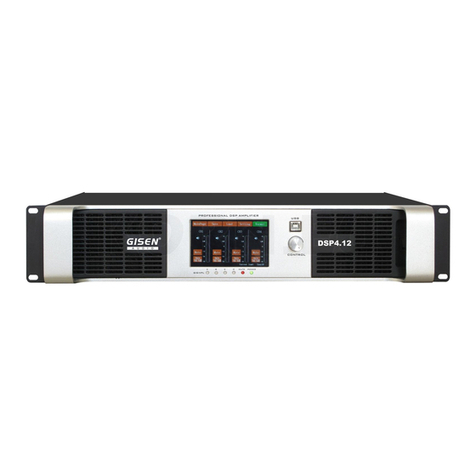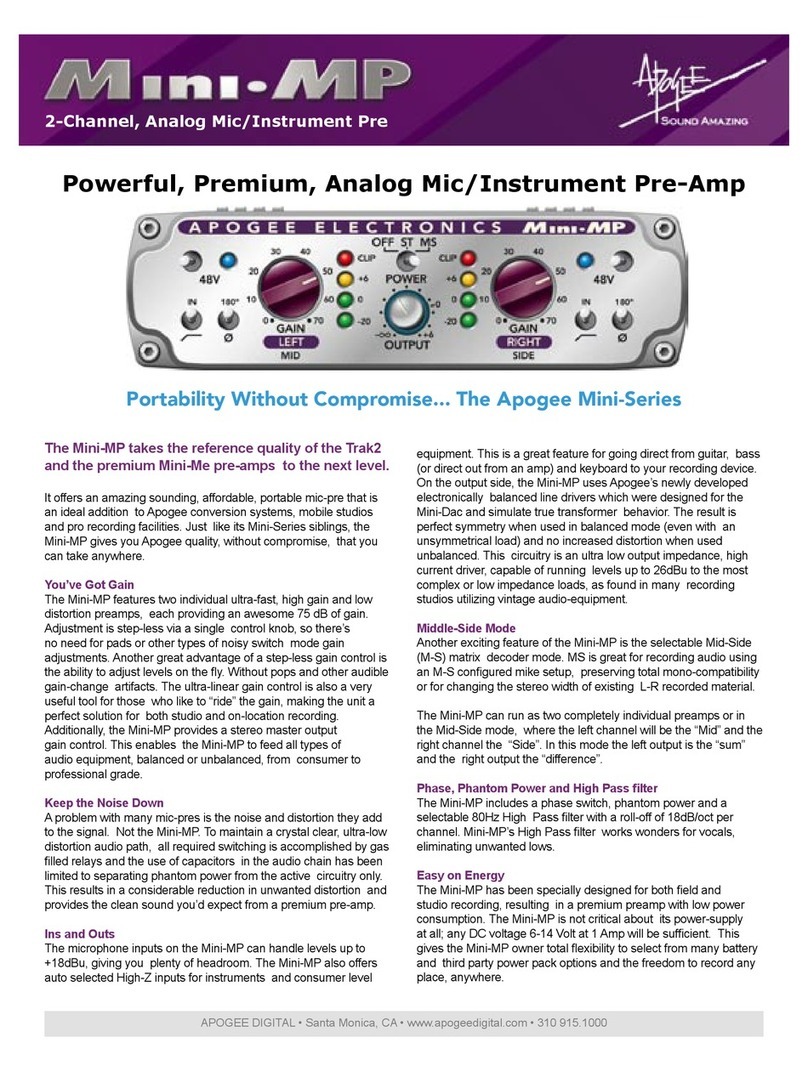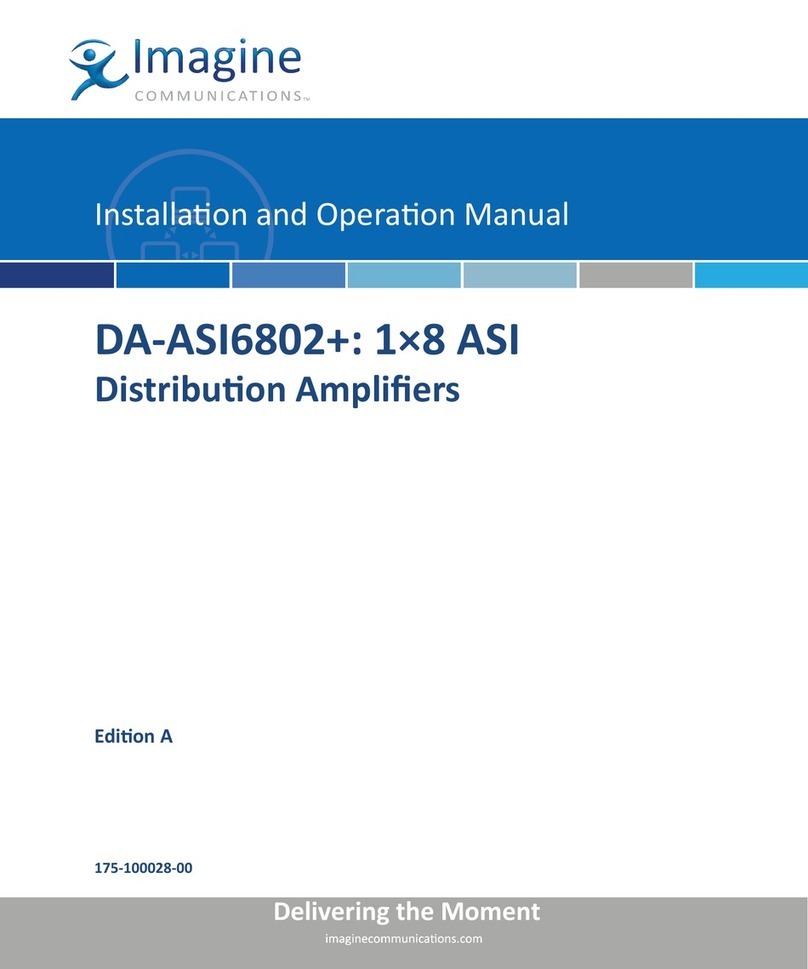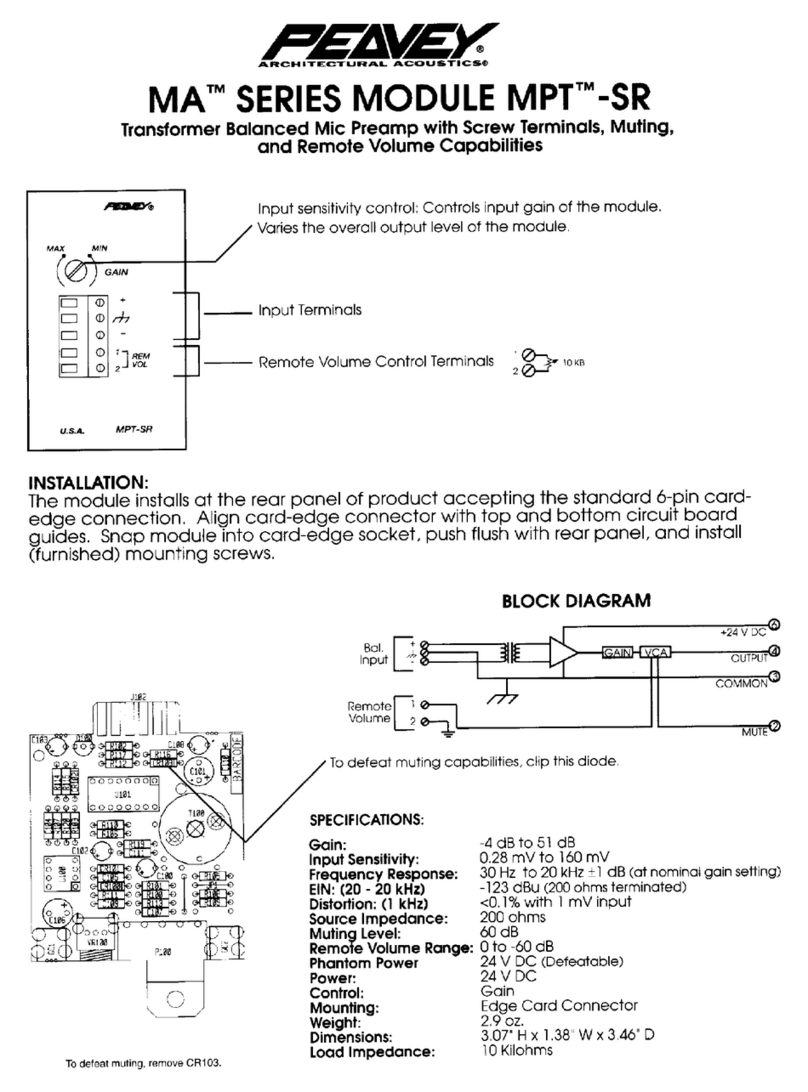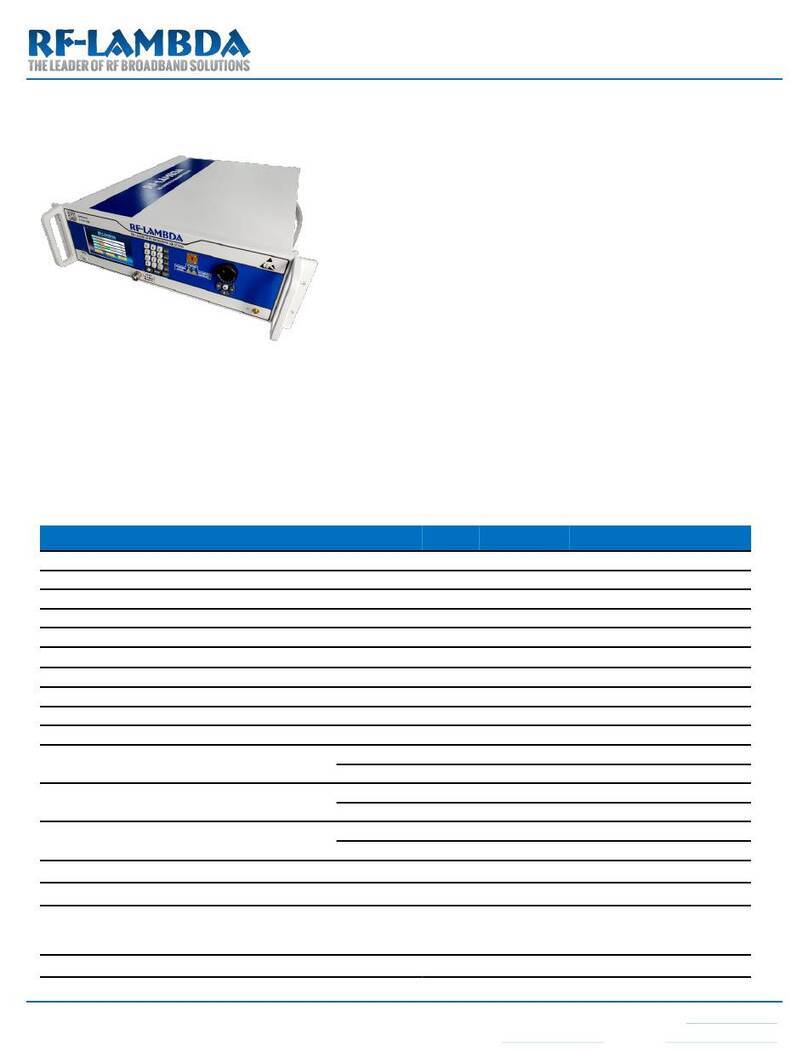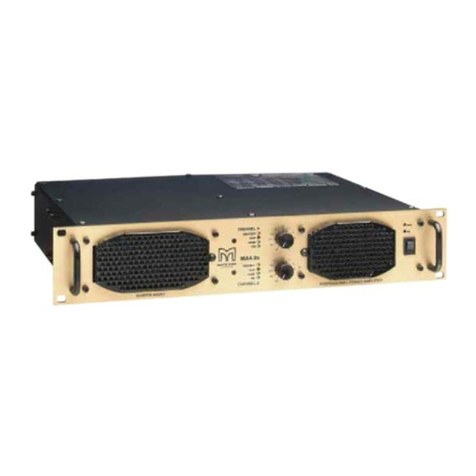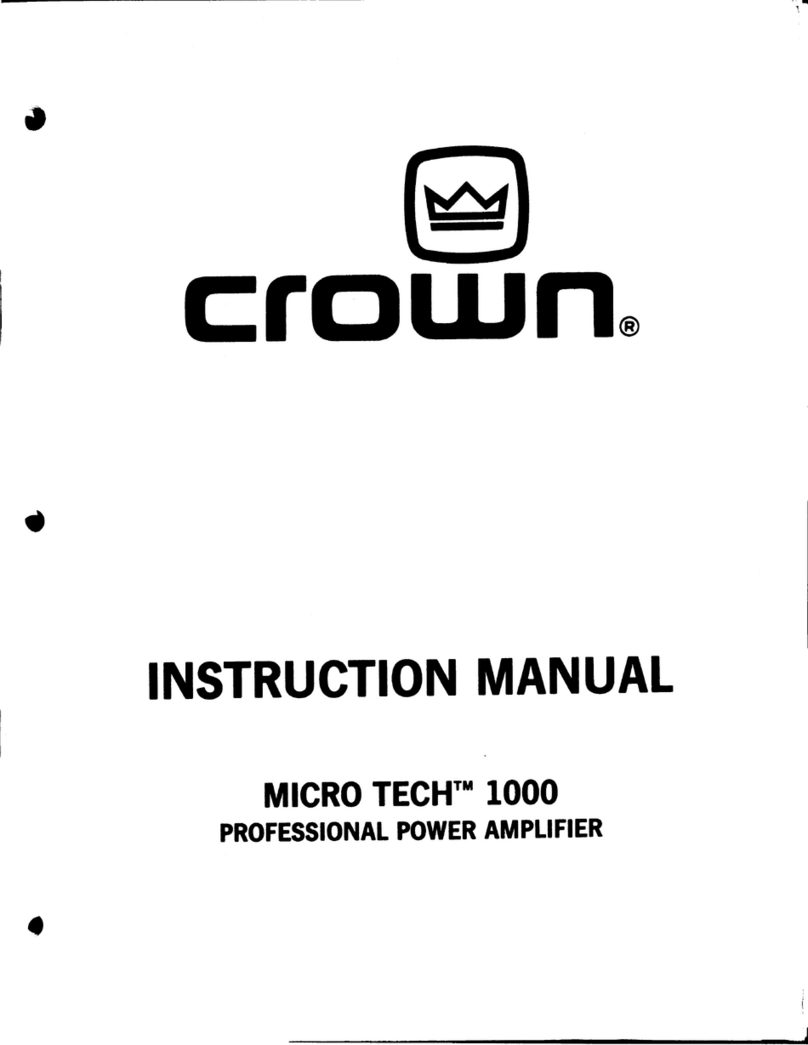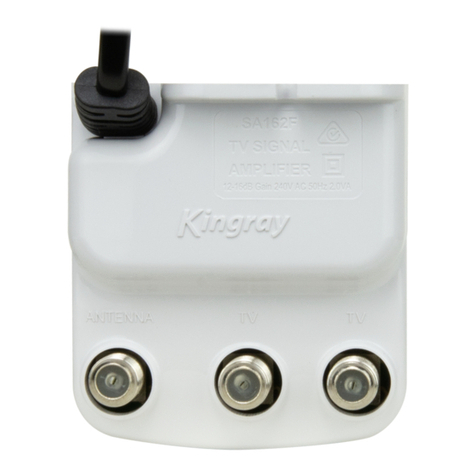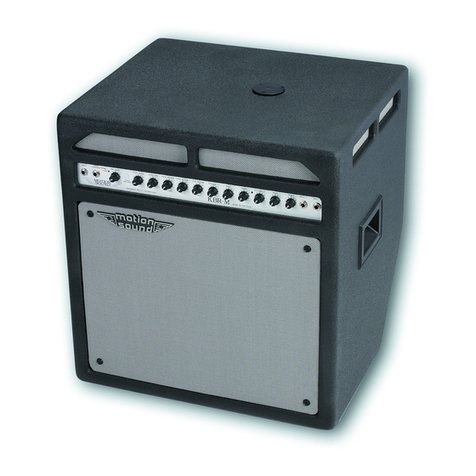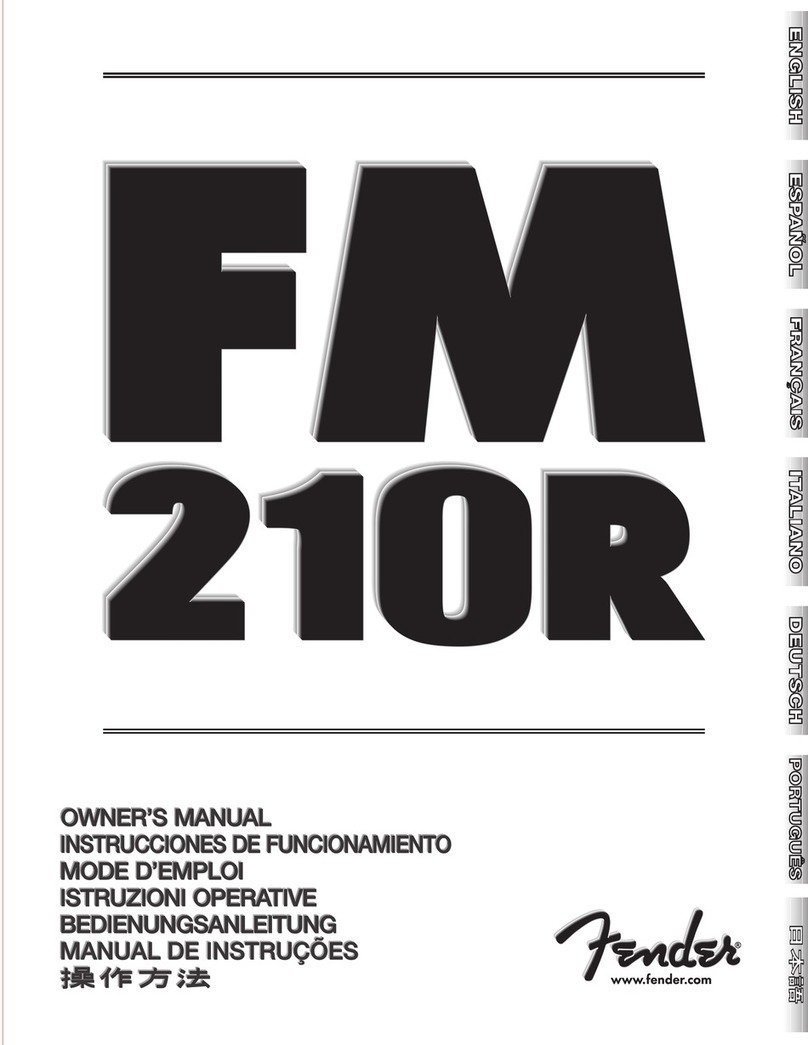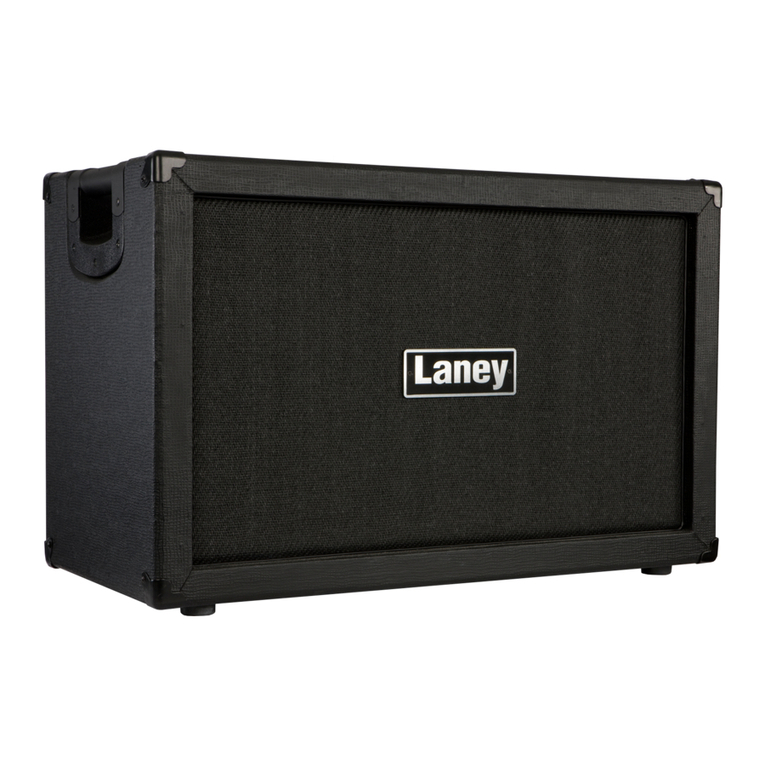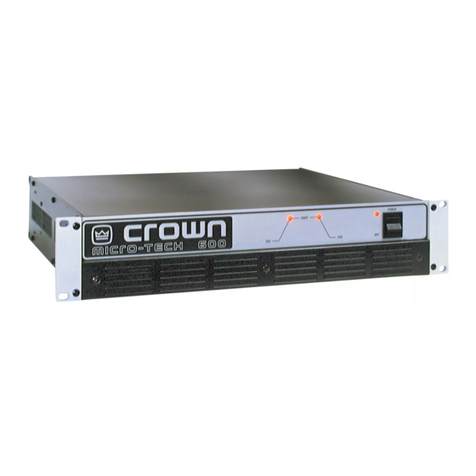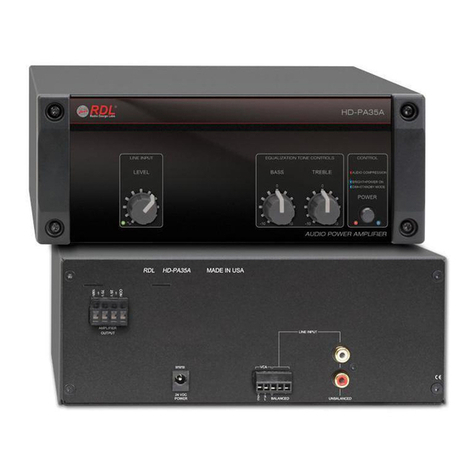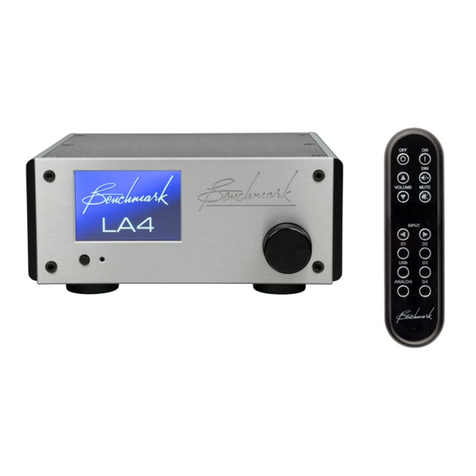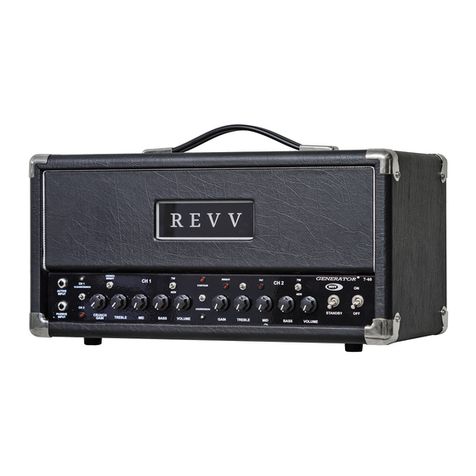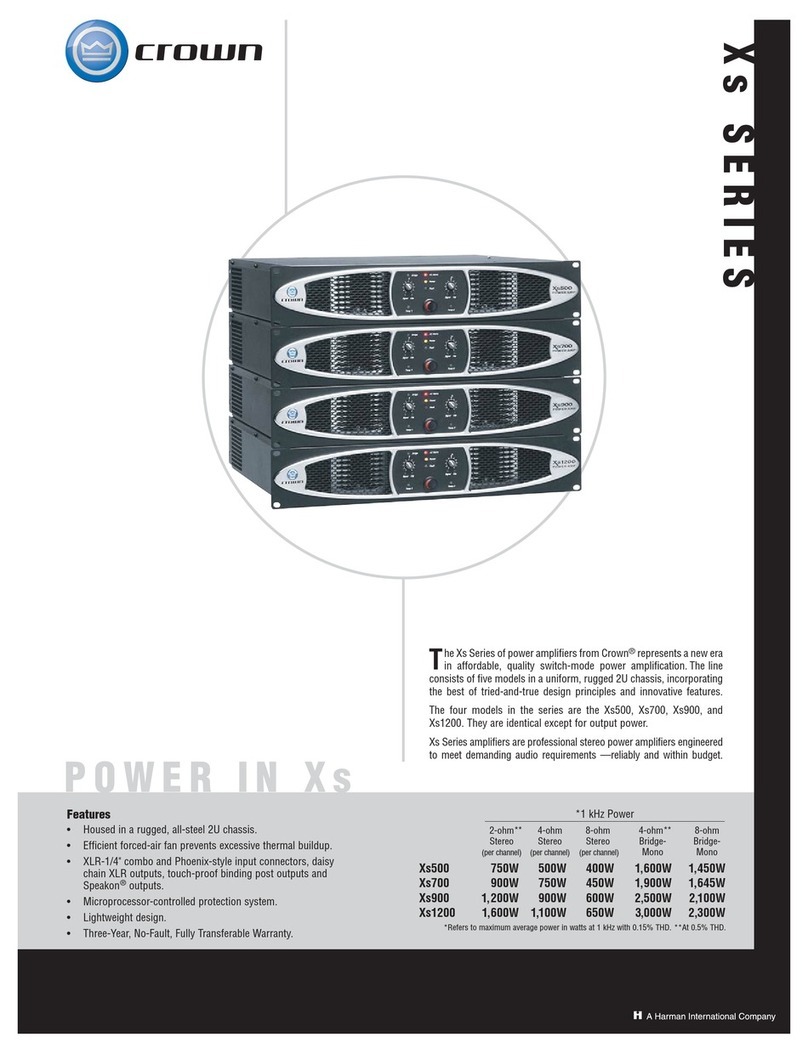Gisen Audio MM Series User manual

MM10K
Operation Manual
MM Series:
Dedicated Touring Amplifiers

2 MM Series Operation Manual
1 CONTENTS.......................................................................................................................................2
2 WARNINGS.......................................................................................................................................4
2.1 Explanation of graphical symbols.....................................................................................................4
2.1.1 WARNING.............................................................................................................................4
2.1.2 CAUTION..............................................................................................................................4
2.2 Important Safety Instructions...................................................................................................... .....4
2.3 User responsibility............................................................................................................................5
2.3.1 Mains connection grounding..................................................................................................5
2.3.2 Speaker output hazard..........................................................................................................5
2.3.3 Radio interference.................................................................................................................5
2.3.4 Speaker damage...................................................................................................................5
2.3.5 Maintenance..........................................................................................................................5
3 WELCOME........................................................................................................................................6
3.1 Introduction......................................................................................................................................6
3.2 Main Features..................................................................................................................................6
3.2.1 Voltage Peak Limiter (VPL.)....................................................................................................6
3.2.2 Protection and performance optimization...............................................................................6
4 INSTALATION ..................................................................................................................................7
4.1 Unpacking.................................................................................................................................7
4.2 Mounting...................................................................................................................................7
5.2.1 Rear support bracket.........................................................................................................8
4.3 Cooling......................................................................................................................................8
4.4 Operating voltage......................................................................................................................8
4.5 Grounding.................................................................................................................................8
5 QUICK GUIDE OVERVIEW ................................................................................................................9
5.1 Front Panel overview...................................................................................................................9
5.1.1 Power on/off and remote switch..........................................................................................9
5.1.2 Front Panel LED's..............................................................................................................9
5.2 Rear Panel overview.................................................................................................................10
5.2.1Configuration section.......................................................................................................11
5.2.2 The DIP-switch features...................................................................................................11
5.2.3 Input and Output connectors...........................................................................................12
6 OPERATION AN D PER FORMANCE ...................................................................................................13
6.1 Introduction.............................................................................................................................13
6.2 Operation precautions.............................................................................................................13
6.3 Signal flow and headroom........................................................................................................13
6.3.1 Signal flow blocks............................................................................................................13
6.3.2 Headroom, sensitivity and VPL / Gain settings..................................................................14

MM Series Operation Manual 3
6.4 Audio Input and Output connections...............................................................................................15
6.4.1 Balanced Input connections...................................................................................................15
6.4.2 Unbalanced Input connection................................................................................................15
6.4.3 Speakon Output connections.................................................................................................16
6.4.4 Binding Post ( BP ) Output connectors...................................................................................16
6.4.5 Output bridge mode...............................................................................................................17
6.4.6 Amplifier Gain........................................................................................................................17
6.4.6.1 Channel gain / Level ( Front-panel pots )......................................................................17
6.4.6.2 Amplifier sensitivity.......................................................................................................17
6.4.7 Output Voltage Peak Limiter, (VPL).......................................................................................18
6.4.8 Output Current Peak Limiter (CPL)........................................................................................18
6.5 Protection, faults and warnings......................................................................................................19
6.5.1 Introduction...........................................................................................................................19
6.5.2 Safe Operating Area Detector (SOAD)..................................................................................19
6.5.3 Very High Frequency (VHF) protection..................................................................................19
6.5.4 DC protection........................................................................................................................19
6.5.5 High-impedance warning (open load)....................................................................................20
6.5.6 Low-impedance protection (short circuit)...............................................................................20
6.5.7 Temperature protection..........................................................................................................20
6.5.8 Power Average Limiter (PAL).................................................................................................20
6.5.9 Soft-Start...............................................................................................................................20
6.6 Front Panel monitoring and adjustments........................................................................................21
6.6.1 Level indicators.....................................................................................................................21
6.6.2 Level adjust...........................................................................................................................21
6.6.3 Mute indication......................................................................................................................21
6.6.4 Performance, Warning and Fault indicators...........................................................................22
7 APENDIX...............................................................................................................................................23
7.1 Maintenance..................................................................................................................................23
7.2 FAQ................................................................................................................................................23
7.3 Current Draw and Thermal Dissipation specifications.....................................................................24
8 TECHNICAL SPECIFICATIONS.............................................................................................................26

2.1 Explanation of graphical symbols
The lightning symbol withina triangle is intendedto alert the userto the presence ofun-insulated“dangerous voltages”within the unit's chassis that maybe of
sufficient magnitude to constitutea risk of electric shockto humans.
The exclamation point withina triangle is intendedto alert the userto presence of importantoperating and service instructionsin the literature accompanyingthe
product.
1. Keep this manual for future reference.
2. Heed all warnings.
3. Follow all instructions.
4. Do not use this unit near water.
5. Do not spill water or other liquidsinto or on the unit. Do not operatethe unit while wet or standing in liquid.
6. Clean only with dry cloth.
7. Do not block the air intake orexhaust ports. Install the unit in accordance withthe instructions.
8. Do not operate the unit near heatproducing devices such as radiators, heat registers, stoves or other apparatus that produce heat.Always operate the unit with the chassis groundwire connected to the
electrical safety earth. Do not defeat the safety purpose of a grounding-type plug.A grounding-type plug has two pinsand a third grounding prong. The thirdprong is provided for your safety. If the provided
plug does not fit into your outlet, consultan electrician for replacement of the obsolete outlet.
9. Connect only to AC poweroutlets rated 100-120 V or 200-240 V, 50-60 Hz as dictated by the unit's voltage configuration.
10. Do not use this unit if thepower cord is broken or frayed. Protect thepower cord from being walked upon or pinched,particularly at the plug and the point whereit exits from the apparatus.
11. Only use accessories specifiedby the manufacturer.
12. The unit is intended to usein a 19 Rack. Follow the mounting instructions. When a rackon wheels is used, use caution when movingthe loaded rack to avoid injury from tippingover.
13. Unplug this apparatus during lightning storms orwhen unused for long periods of time.
14. Do not connect the unit's outputs in parallel or series with any otherunit's output. Do not connect the unit's output to any other voltage source, such asbattery, mains source, or powersupply, regardless
of whether the unit is turned on oroff.
15. Do not run any of the unit's outputs back into another channel's input.
16. Refer all servicing to qualified service personnel.Servicing is required when the apparatus has beendamaged in any way such as:
Power-supply cord or plug is damaged.
Liquid has been spilled into the unit
An object has fallen into theunit
The unit has been exposed to rainor moisture
The unit does not operate normally
The unit was dropped or the chassisis damaged
17. Do not remove top or bottom covers.Removal of the covers will expose hazardous voltages.There are no user serviceable parts insideand removal may void the warranty.
18. An experienced user shall alwayssupervise this professional audio equipment, especially if inexperiencedadults or minors are using the equipment.
19. The mains plug is used asthe disconnect device and shall remain readily accessible.If the mains plug is not readily accessibledue to mounting in a 19 rack, then the mains plug for the entirerack must be
readily accessible.
20. The US National Differencescl.16.3 requiresthat network cables must be flame rated VW-1.
”
”
2.1.1 WARNING
2.1.2 CAUTION
2.2 Important Safety Instructions
Before using your MM Seriesproduct, be sure to carefullyread the applicable items ofthis Operation Manual and theSafety Instructions.
To reducethe risk of fire or electricshock, do not remove screws. Nouser-serviceable parts inside. Refer servicing toqualified service personnel
4 MM Series Operation Manual

2.3 U ser responsibility
2.3.1 Mains connection grounding
Your amplifier must be connected to a
grounded socket outlet.
2.3.2 Speaker output hazard
Power amplifiers are capable of producing
hazardous output voltages. To avoid electrical
shock, do not touch any exposed speaker wiring
while the amplifier is operating. The external wiring
connected to the speaker terminals shall be installed
by a qualified instructed person or ready-made leads
or cords of appropriate capacity shall be used.
As the amplifier outputs produce high voltage, do
not connect or disconnect speaker cables when
the mains power is on.Also, attach the safety cover
on the speaker terminals for safe operation and to
comply with electrical product approvals.
2.3.3 Radio interference
This product uses radio
frequency energy and if not used or installed in
accordance with these operating instructions, may
cause interference to other equipment, such as radio
receivers. However, there is no guarantee that
Interference will not occur in a particular installation.
If this equipment does cause harmful interference
to radio or television reception, which can be determined
by turning the equipment on and off, the user
is encouraged to try to correct the interference by
one or more of the following measures:
Reorient or relocate the antenna.
Increase the separation between the equipment
and receiver.
Connect the equipment to an outlet on a circuit
different from that to which the receiver is
MM Series Operation Manual 5
Your amplifier is very powerful and can be
potentially dangerous to both loudspeakers and
humans alike. Many loudspeakers can be easily
damaged or destroyed by overpowering them.Always
check the speaker's continuous and peak power
capabilities. Although the amplifier's attenuators can
be used to reduce the overall gain, anincrease of the
input signal can result in full output power, which
Forsafe and reliableoperation,the dustcoversbehind
the front panel should be cleaned regularly. If the dust
filters are not maintained there will be safety risks.
For example the unit can ignite the dust and a fire
will occur due to high internal temperatures. There
is also a risk that the unit will malfunction since it is
dependent on constant airflow from front to rear. If
the dust filters are not clean and theunit malfunctions,
any resultant problems will not be covered by
2.3.4 Speaker damage
may cause damage to connected speakers.
2.3.5 Maintenance
the warranty.
Check if the affected unit complies withthe EMC
limits forimmunity,(CE-labeled).Ifnot,address
the problemwith themanufacturer orsupplier.
Allelectricalproducts sold intheEC mustbe appr-
ovedforimmunityagainstelectromagneticfields,
highvoltageflashes,andradiointerference.
Consult the dealeror an experiencedRadio/TV
technicianforhelp.

3.1 Introduction
Thank you for choosing MM Series power amplifiers
for your sound reinforcement system. We are confident
that you will be pleased with the performance,
configuration flexibility, reliability, and long-term
durability offered by the MM Series products.
This manual provides a comprehensive guide to the
features and functionality of MM Series amplifiers.
Please read through it to become fully acquainted
with the many configuration options and multiple
layers of protection circuitry. To facilitate timely
installation and use of this MM Series product, we
have included a Quick Guide Overview (section 5).
This brief summary, in conjunction with Installation
(section 4), contains the basic information needed
to safely install the amplifier and place it in service.
However, we highly recommend reading through this
manual in its entirety, beginning with Main Features
and Technologies and continuing through Operation
and Performance. As you become thoroughly familiar
with all aspects of operation, you may learn of features
or options that will affect your choices on amplifier
modes or loudspeaker system configuration.
3.2 Main Features
The MM Series incorporates a number of sophisticated
technologies - many of them proprietary to ensure the
best possible performance and many years of reliable
operation. Familiarizing yourself with these technologies
will prove invaluable in setting up and optimizing your
loudspeaker system.
3.2.1Voltage Peak Limiter (VPL)
The Voltage Peak Limiter (VPL) feature allows
user adjustments that determine maximum voltage
output, thus matching the amplifier to the connected
Speaker load. Regardless of load impedance,
the VPL feature can be set to ensure that.
Neither temperature nor current limitations are
exceeded before reaching the desired voltage
threshold.
6 MM Series Operation Manual
3.2.2 Protection and performance
optimization
Appropriate and reliable power amplification is vital
to any audio system. Inadequate or faulty power
amplification could cause damage to the loudspeakers,
or in some cases to the power amplifiers themselves.
To prevent any damage or costly service interruptions,
MM Series amplifiers offer advanced features to
protect both internal circuits and any connected loads.
These features even protect the mains fuse that, in
extreme cases, could be overloaded.
Following are short descriptions of standard built-in
MM Series protection features:
CPL, (Current Peak Limiter) ensures that the am-
plifier's output does not exceed the safe current
handling parameters of amplifier components.
Temperature protection ensures that the
amplifier will not be damaged by exceeding
thermal limits.
PAL , (Power Average Limiter) limits the maximum
average power consumption according to the
power supply and mains-breaker capabilities.
VHF, (Very High Frequency) protection circuits
mute the output of the amplifier when non-
dynamic continuous signals above 10 kHz are
detected.
DC protection ensures destructive DC signals
will not appear at the amplifier outputs. If such
conditions occur an internal fuse opens and fault
indication is displayed.
Low-impedance (short circuit) protection pro-
vides a fault warning indication and shuts down
the output stage when, for example, an input
signal is present and a malfunctioning cable or
driver is short circuiting the output.
High-impedance warning reports an alert when,
at the same time, output signal is high and no
current draw is measured. This situation might
occur when no speakers are connected, or when
a driver is blown.
Low inrush current ensures that the mains
breaker will not trip when several power am-
plifiers are turned on simultaneously.

4.1 Unpacking
Carefully open the shipping carton and check for any
noticeable damage. Every amplifier is tested and
Inspected before leaving the factory and should
Arrive In perfect condition. If any damage is discovered,
Please notify the shipping company immediately.
Only the consignee may institute a claim with the
Carrier for damage incurred during shipping. Save
The carton and packing materials for the carrier's
inspection. Should you ever need to ship the amplifier,
always use the original packaging materials.
4.2 Mounting
Free airflow from front-to-rear of the amplifier must
be possible. Therefore, no doors or rack-lids should
be mounted in front of or behind the amplifiers.
Amplifiers may be stacked directly on top of each
other. There is no need for spacing in between units,
though this might enable more convenient installation
of cabling on the rear panel.
It is recommended that rear supports be mounted for
maximum long-term stability. Rear support brackets
are included.
Figure 4.2b: Use washer for fixed installation
Figure 4.2c: Use tube for slide-on installation.
Figure 4.2a: Rear support mounting hardware
2x 2x
2x
MM Series Operation Manual 7

4.3 Cooling
The amplifier uses a forced-air cooling system with
Air flow from front to rear, maintaining a low operating
Temperature within defined limits. Front-to-rear airflow
is preferred as cooler air is present at the front in
Nearly all applications. (This allows higher continuous
Power levels without encountering thermal problems.)
Never attempt to reverse the airflow. The amplifier
Modules require a pressure chamber between the
fans and heatsink, and this effect functions only in
one direction.
Make sure that there is an adequate air supply in front
of the amplifier, and that the rear of the amplifier has
sufficient space to allow the exhaust to escape. If
the amplifier is rack-mounted, do not use covers or
doors on the front or rear of the rack.
Should a heat sink overheat, the temperature
sensing circuits will mute the overheating channel.
If the power supply overheats, another sensing
circuit will mute all output channels until the power
supply cools to safe operating temperature.
Always make sure that the dust-filters behind the
detachable front panel are clean to ensure maximum
possible airflow.
If the amplifier malfunctions due to dirty
dust filters, any required repairs are not
covered by the warranty.
4.4 Operating voltage
The label placed to the right of the mains
cable on the rear of the amplifier indicates the
AC mains voltage for which the amplifier is wired
and approved: 115 V or 230 V. Connect the power
cable only to the AC source type referred to on the
label. The warranty will not cover damage caused by
connecting to an incorrect type of AC mains.
The amplifiers use primary witching. Because the mains
power is rectified directly in front of the transformer, the
amplifier is insensitive to mains frequency. It may be
connected to 50 or 60 Hz sources, and actually will
operate on line frequencies from DC to 400 Hz.
If the power plug mounted at the factory is not
appropriate for your country, it can be removed and
the proper connector wired in its place as follows:
BLACK or BROWN LIVE
WHITE or BLUE NEUTRAL
GREEN or GREEN/YELLOW EARTH(GROUND)
If you are not 100% confident of your
competence to replace the mains plug, engage
qualified personnel to do the job.
Once a suitable AC supply is connected, the
amplifier can be turned on using the front panel
power switch. The amplifier then goes through a
soft-start sequence as it self-checks its circuits. The
fans will blow at high speed before dropping to idle,
and the power LED will illuminate.“”
Inrush power is controlled and limited during softstart ,“”
enabling multiple amplifiers to be powered up
Simultaneously.
4.5 Grounding
There is no ground lift switch or terminal on the
FP+ Series amplifiers. The signal ground is always
floating, via a resistor, to chassis and therefore the
grounding system is automatic.
In the interests of safety, never disconnect the earth
(ground) pin on the AC power cord.
Use balanced input connections to avoid hum and
Interference.
NOTE
8 MM Series Operation Manual

MM10K
The amplifier's front panel presents the performance
and fault condition indicators, power and remote
switches, and a removable dust-filter cover. Level
potentiometers provide individual attenuation for the
amplifier channels. Range is 0 dB to - infinity. (The
12 o'clock position indicates -10 dB attenuation.) A
convenient label strip with writing surface is provided
adjacent to each level potentiometer.
To remove the dust-filter covers, loosen the thumb-
screws located underneath the front handles. This
allows removal of the dust-filters for cleaning. The
covers may be made tamper resistant by replacing“”
the thumbscrews with Philips head or safety Torx
screw. Thread size is M3.
The amplifier never should be operated
without the dust-filters in place.
5.1.1 Power on/off and remote switch
The Power on/off switch is located on the right side.
A second switch, labeled REMOTE is above the“”,
Power switch.
5.1.2 Front-panel LED's
The front-panel LED area includes the following
indicators per channel:
Figure 5.1.2a: Front panel LED field (per-
channel)
VHF - Very High Frequency protection active (output muted)
(Yellow constant)
TEM - Temperature warning (Yellow flashing)
TEM - Temperature mute (Yellow constant)
CPL - Current Peak Limiter (CPL) active (Orange flashing)
CPL - (Orange constant with output muted): Low impedance
/ short circuit detection fault
VPL - Voltage Peak Limiter (VPL) active
SIG - Signal levels - 40 dB (Sig) to- 4 dB
Hi-Imp - High-impedance/open load detected (Orange)
Bridge - Bridge mode operation (Yellow)
When no VPL, CPL or PAL indicators are illumi-
nated, and the VPL DIP-switch is set to maximum
at the specified nominal load, the amplifier
channel is able to deliver maximum rated output
power
NOTE
NOTE
Power on (Green)
Figure 5.1.2b: Front panel global LED field
5.1 F ront-Panel overview
MM Series Operation Manual 9

4 channel version
shown with Neutrik
Speakon output
connectors
Mains input 115 V
or 230 V operation
(Not selectable)
DIP-switches
for adjusting key
features
(See below)
XLR connectors for
inputs and loop thru
5.2 Rear-Panel overview
Figure 5.2: Two- and four-channel speaker output connector options (not applicable to all models)
Rear view of two-channel model fitted with Speakon connectors
Rear view of four-channel model fitted with Speakon connectors
10 MM Series Operation Manual

5.2.1 Configuration section
Four-channel model shown. Two-channel versions
have VPL and Bridge Mode switches for channels
A and B only. All models have different VPLvalues.
Functions are otherwise identical.
Gain - Globally set for all channels, from +23 dB to
+44 dB in 3 dB steps.
Option active - Not currently implemented.
Fan Masked - When on, engages the intelligent
fan feature; fan speed is lowered when no signal is
present.
Bridge A+B and C+D- Switches the channel pairs
into bridge mode operation An automatic -6 dB gain
compensation is applied.
VPL - The Voltage Peak Limiter provides optimum
peak voltage settings for each channel. Level
selections vary by model within the FP+ Series.
Mode - Select VPL mode to either Hard or Soft
operation. For channels driving sub-woofers and
low-frequency drivers, it is recommended to use
the Hard setting for optimal operation. For mid- and
high- frequency drivers, always select Soft.
5.2.2 The DIP-switch features
The following features may be adjusted using the
DIP-switches on the rear panel of the amplifier
Figure 5.2.2a: Rear panel DIP-switch field
Table 5.2.2b: VPL voltage selections in Standard Mode
Table 5.2.2c: VPL voltage selections in Bridge Mode
NOTE
MM Series Operation Manual 11
195 V 390 V 340 V 310 V 242 V 300 V 202 V
170 V 340 V 280 V 242 V 202 V 242 V 166 V
140 V 280 V 232 V 202 V 166 V 202 V 140 V
116 V 232 V 200 V 16 6 V 140 V 166 V 112 V
100 V 200 V 1 60 V 140 V 112 V 140 V 9 4 V
80 V 160 V 13 2 V 112 V 94 V 112 V 76 V
66 V 132 V 10 8 V 94 V 76 V 94 V n/ a
54 V 108 V n/a 76 V n/a 76 V n/a
VPL in Bridge Mode
MM14K MM13K MM9K MM7K MM4K MM10K MM6K
MM 14K MM 13K MM9K MM7K MM4K MM10K MM6K
195 V 195 V 170 V 155 V 121 V 150 V 101 V
170 V 170 V 140 V 121 V 101 V 121 V 83 V
140 V 140 V 116 V 10 1 V 83 V 101 V 70 V
116 V 116 V 100 V 83 V 70 V 83 V 56 V
100 V 100 V 8 0 V 70 V 56 V 70 V 47 V
80 V 80 V 66 V 56 V 47 V 56 V 38 V
66 V 66 V 54 V 47 V 38 V 47 V n/a
54 V 54 V n/a 3 8 V n/a 38 V n/ a
VPL in Standard Mode

5.2.3 Input and Output connectors
All MM Series amplifiers are equipped with balanced XLR-F input connectors. two-channel models also offer
parallel ( oop-thru ) XLR-M output connectors for daisy-chaining multiple amplifiers from the same signal“”
source.
All MM Series amplifiers except the MM9K, MM13K and MM14K offer a choice of either binding post
(BP) or Neutrik. NL4FC Speakon output connectors (SP). The MM9K, MM13K and MM14K are offered
with BP connectors only as the potential maximum output current exceeds the recommended limits for the
Speakon connectors.
For specific configuration and wiring information, see section 5.4.
Figure 5.2.3a: Two- and four-channel input connector configurations
Audio inputs - four-channel models Audio inputs and loop-thru connectors -
two-channel models
Figure 5.2.3b: Two- and four-channel speaker output configurations
Speakon outputs - four-channel models Speakon outputs - two-channel models
12 MM Series Operation Manual

Input Amplifier Level control Clip limiter Voltage Peak Limiter Output Power Amplifier
Gain select switches Front panel
potentiometer
Dynamic
Gain reduction
VPL select switches
Hard/Soft switch
Current clip sensing
Voltage Clip sensing
Class HTD
Monitoring Level
Temperature
Fault/Warning
Control Mute
6.1 Introduction
The following sections provide comprehensive
information on amplifier connection, setup, operation,
and performance. The detailed information included
here is essential to realizing the full functionality of
the MM Series amplifiers.
6.2 Operation precautions
Make sure that the Power switch and the Remote
switch on the amplifier front panel are set to
off before making any input, output or network“”
connections, and also before manipulating the
DIP-switches on the rear panel.
Make sure that the AC mains voltage is correct
and matches the voltage printed on the rear panel
of the amplifier (115 V or 230 V).
Make sure that no signal is present at the input
to the amplifier when powering up. An input
signal could produce an unintentionally loud initial
volume from the speakers.
6.3 Signal flow and headroom
6.3.1 Signal flow blocks
All MM Series amplifiers have the same signal flow,
and the same feature sets. The only internal differ-
ences are in the maximum output current per channel
and VPL settings.
The input stage of all MM Series amplifiers has a
high sensitivity to provide ample system headroom.
This in effect means that the input stage is almost
impossible to clip.
Overall amplifier input gain is adjusted using the
input stage DIP-switches. Please note that the gain
setting is global, affecting all channels. Following
the input stage, the dedicated level control on each
channel allows signal attenuation from 0 dB to minus
infinity.
The Current Peak Limiter (CPL) section dynamically
limits the input signal based on three parameters:
sensed current level, feedback from the output stage,
and sensed voltage clip from the VPL (and output
amplifier voltage clip if Soft Clip is activated). This“”
ensures that power output is maintained within the
design limits of the amplifier.
The adjustable Voltage Peak Limiter (VPL) sets the
maximum output voltage and therefore also the
maximum output power. Eight different voltage
stages are available using the DIP-switches on the
rear panel of all models, except the MM9K and MM4K
that both have seven stages and the MM6K
which provides six voltage stages.
The sophisticated output section monitors faults
And generates appropriate warnings.
These alerts allow
The operator to adjust system settings and thereby
avoid problems. In the rare event that conditions are
extraordinarily severe, the amplifier will shut down
until the fault or problem setting has been rectified
or adjusted. These sensing circuits are also employed
to feed back voltage and current level information,
via a side chain, to the limiters. Sensing circuits
also transmit local amplifier module temperature
and power supply temperature to the appropriate
protection mechanisms. Read the Protection, Faults
and Warnings section for further details.
MM Series Operation Manual 13

6.3.2 H eadroom, sensitivity and VPL / Gain
settings
The input amplifier and limiter system is designed
to accommodate extremes of performance. Typically,
exceeding maximum input by much as +10 dB
will only result in a 1% increase in distortion. The
following schematics illustrate how the adjustable
VPL and Gain circuitry affect input sensitivity and
output power.
The tables to the left of the illustration 7.3.2 below
show input sensitivity for a FP 13000 with a 2 ohm
load and 195 V peak (max.) and 54 V peak (min.)
Respectively for the eight different gain stages
between +23 dB and +44 dB. The resulting output
power is displayed in dBu, Vrms and watts in the
tables to the far right.
The headroom available through the input stage to
the clip limiter is shown by the dotted lines as +10
dB at 195 V peak and +16.1 dB at 54 V peak. These
lines illustrate the additional signal level that can be
accepted at the input before any significant distortion
will appear at the input stage.
If you use the level potentiometer in the
signal chain to reduce the level by an amount
greater than the headroom relative to input
sensitivity, AND you drive the amplifier
to clip level, you are in danger of clipping the input
stage before the current or voltage peak limiters are
activated.
When bridging two channels, you must
add +6 dB to the input sensitivity to achieve
maximum output voltage due to the
automatic -6 dB gain compensation
inserted by the amplifier.
NOTE
NOTE
+ 44 dB
+ 41 dB
+ 38 dB
+ 35 dB
+ 32 dB
+ 29 dB
+ 26 dB
+ 23 dB
1,0 / 0,87
4,0 / 1,23
7,0 / 1,7
10,0 / 2,5
13,0 / 3,5
16,0 / 4,9
19,0 / 6,9
22,0 / 9,8
+ 44 dB
+ 41 dB
+ 38 dB
+ 35 dB
+ 32 dB
+ 29 dB
+ 26 dB
+ 23 dB
-10,1 / 0,24
-7,1 / 0,34
-4,1 / 0,5
-1,1 / 0,7
1,9 / 1,0
4,9 / 1,4
7,9 / 1,9
10,9, / 2,7
Input
sensitivity
dBu / Vrms
Gain set to:
(DIP-switches)
VPL set to 54 VPEAK
VPL set to 195 VPEAK
+ 10 dB headroom to clip
relative to input sensitivity *)
+ 16,1 dB headroom to clip
relative to input sensitivity*)
Voltage Peak
Limiter set to:
(DIP-switches)
195 Vpeak
170 Vpeak
140 Vpeak
116 V peak
100 Vpeak
80 Vpeak
66 Vpeak
54 Vpeak
6.500 W
6.500 W
4.970 W
3.540 W
2.550 W
1.850 W
1.330 W
960 W
Output Power
@ 2 Ohm
Watt
Output
power
dBu / Vrms
45,0 / 138
43,8 / 120
42,1 / 99
40,5 / 82
39,2 / 71
37,3 / 57
35,6 / 47
33,9 / 38
Complete tables forall
VPLsettings
Input
sensitivity
dBu / Vrms
Gain set to:
(DIP-switches)
*) Headrom limited to+5dB at Gain setto +23 dB atMax. VPL
Figure 6.3.2: MM13K VPL and GAIN settings
Input Amplifier Level control Clip limiter Voltage Peak Limiter Output Power Amplifier
Gain select switches Front panel
potentiometer
Dynamic
Gain reduction
VPL select switches
Hard/Soft switch
Current clip sensing
Voltage Clip sensing
Class HTD
Monitoring Level
Temperature
Fault/Warning
Control Mute
14 MM Series Operation Manual

When linking the same source signal to
several input channels, be aware that there
is a limit to the number of channels an
output source can drive . A typical output“”
source (e.g. a DSP crossover unit) can drive up to
four amplifier channels before external line-drivers
might be required to buffer the signal.
6.4.2 Unbalanced Input connections
6.4 Audio Input and Output
connections
6.4.1 Balanced Input connections
Figure 6.4.1a: Audio inputs and loop-thru
connectors - two-channel models
Figure 6.4.1a: Audio inputs - four-channel
models
The XLR input connectors are electronically balanced,
and wired according to the IEC 268 standard
(pin 2 = hot). XLR input connectors should be wired
as follows:
Pin 1 Ground/shield
Pin 2 Hot (+)
Pin 3 Cold (-)
Figure 6.4.2: Unbalanced XLR wiring schematic
To connect an input to an unbalanced source, it is
possible to connect pins 1 and 3 in the XLR plug at
the amplifier end of the cable. However, a better
method is to connect pin 3 to the shield at the source
end of the cable, as this usually results in better hum
and noise rejection. Balanced input connections are
recommended whenever possible.
6.4.3 Speakon Output connections
Refer to the instructions in this section if your amplifier
is equipped with the Speakon output connectors.
Figure 6.4.3a: Speakon outputs - two-channel
models
Figure 6.4.3b: Speakon outputs - four-channel
models
Figure 6.4.1c: Balanced XLR wiring schematic
NOTE
12
3
Gnd
12
3
MM Series Operation Manual 15

Two-channel amplifiers - Two-channel amplifiers
are wired in the following manner. The right Speakon
connector, Channel A+B, provides outputs for both
Channel A and Channel B. This output is useful when
wiring the amplifier for bridged mono operation. See
section 6.4.6. The left Speakon connector provides
an output for Channel B only.
Connect the + and - loudspeaker cables as shown
in the illustrations below.
Four-channel amplifiers - Additional connectors
are provided for Channel C and Channel D. Channel
C functions as Channel A above, and Channel D as
Channel B above.
Figure 6.4.3c: Speakon wiring schematic
The outputs on all MM Series amplifiers
produce high voltage. Do not connect or
disconnect the loudspeaker cables while the mains
power is on. Never operate the amplifier with any
portion of bare loudspeaker wire exposed. Also,
attach the safety cover (4-channel Speakon
versions only) on the speaker terminals for safe
operation and to comply with electrical product
approvals.
Channel Aand B into two
separate Speakons
Channel Aand B into one
Speakon (Stereo andBi-amp)
Bridge mono
16 MM Series Operation Manual

Never connect an output terminal to ground,
or to any other input or output. Observe
relative loudspeaker polarity: loudspeakers
connected in reverse polarity will exhibit
degraded performance, particularly in bass frequen-
cies, and may be damaged as a consequence.
Use a high-quality stranded loudspeaker
cable, and keep cable runs as short as
possible.
6.4.5 Output bridge mode
It is possible to bridge channels in two-channel ver-
sions, or in pairs of two (A+B and C+D) in four-channel
versions. When bridged, the input source must be
connected to input A(A+B) or C (C+D) respectively.
Output speaker cables must be connected to the
plus pole on channel A or C and the minus pole on
B or D.
The main benefit of bridging the output is a doubling
of output voltage. Bridging can be used to turn a
four-channel MM10K amplifier, for example into
a three-channel amplifier with 2 x 1300 W and 1 x
4200 W at 8 ohms or 2 x 2100 W and 1 x 5000 W
at 4 ohms.
Most power amplifier designs, when bridged, auto-
matically introduce a +6 dB input gain boost which
can lead the user to conclude that said amplifier
delivers“more than double the power”when in
bridge mode. This is clearly not the case, as the
gain boost artificially enhances perceived power at
the cost of headroom. The MM Series amplifiers
work on globally set constant gain, and automatically
compensate the input gain by -6 dB. For example, if
the amplifier is configured in a three-channel mode,
then the selected gain is maintained from input to
output on all channels.
6.4.6 Amplifier Gain
All MM Series amplifiers feature adjustable input gain.
This versatility enables the amplifier to accommodate
a multitude of system configurations with various
input sources and speaker layouts. Amplifier gain is
set globally for all channels. The range is +23 dB to
+44 dB in 3 dB steps. Individual channel fine level
adjustment is available using the potentiometers on
the front panel.
The unique adjustable input gain feature of the
MM Series makes it easier to attain the optimum
balance between headroom and signal-to-noise ratio
in the signal path. A weak signal at the input might
require the gain to be raised in order to achieve maxi-
mum output power with the lowest signal-to-noise
ratio. A “hot”input signal, however, would require
a lowering of the gain to avoid sending the amplifier
into Voltage or Current clipping. See Appendix to
review the table containing Gain versus VPL setting
implications for input sensitivity and output power.
Bridge mode operation automatically compensates
by -6 dB, keeping all channels at the same gain.
6.4.6.1 Channel gain/level (front-panel pots)
Individual channel gain (level) may be adjusted using
the potentiometers located on the front panel. Range
is from 0 dB to -infinity in 31 steps. The attenuation
is logarithmic, with the 12 o 'clock position indicating
-10 dB.
If the level control is used to attenuate to a
lower level than the headroom relative to
input sensitivity AND the amplifier input is
driven into clip, there is a danger of clipping
the input stage before the current or voltage peak
limiters are activated.
6.4.6.2 Amplifier sensitivity
Sensitivity is defined as how many Volts (rms) or
dBu (referred to 0.775 Vrms) are required to achieve
full (maximum) output power. As the output power
varies with the load impedance, 4 ohms is usually
the common reference. Since MM Series amplifiers
are capable of providing multiple maximum output
power levels through use of the VPL feature, many
sensitivity calculations may be required for a single
amplifier. We recommend use of the DeviceControl
software to simplify this process. DeviceControl's
Device View page, used in combination with the
DIP-switch settings display, will automatically produce
a sensitivity calculation from the given data (VPL,
Gain and load).
NOTE
NOTE
NOTE
MM Series Operation Manual 17

6.4.7 Output Voltage Peak Limiter (VPL)
Voltage Peak Limiter (VPL) is a unique feature in
MM Series amplifiers. It is used to select the maxi-
mum power available on each output channel. VPL
levels are set using the rear-panel DIP-switches;
eight level positions are offered on all models except
the MM6K, which offers six).
The values for VPL are displayed as maximum Voltage
Peak. To translate Voltage Peak into Vrms, you must
divide the Voltage Peak values by 1.41 (see table).
The VPL allows you to set the correct maximum
output peak power for optimum performance with
the connected speakers. The correct setting depends
on the system type and the specific load connected
to the channel. Since each channel can be configured
to deliver either very high voltage peak power OR
high current draw at low-impedances, it is important
to set the VPL correctly.
If you choose a lower VPL setting, you only reduce
the maximum output voltage. At the same time, this
allows more current headroom for low-impedance
loads. The amplifier thus runs at higher efficiency,
with a significantly reduced risk of going into thermal
protection.
6.4.8 Output Current Peak Limiter (CPL)
The Current Peak Limiter (CPL) ensures that the
amplifier will not be damaged by forcing the amplifier
to deliver current levels to the outputs that exceed the
physical limits of the transistors. The CPL keeps the
amplifier within the Safe Operating Area (SOA).
The CPL is non-adjustable and has different limit
values depending on model type.
CPL activity is indicated by illumination of an orange
LED for each channel on the front panel. Warnings
also are shown in the DeviceControl software's
GUI.
A steadily illuminated orange CPL LED (with MUTE
illuminated) indicates a short circuit situation (or very
low-impedance). The output will mute for 6 seconds
before measuring the output impedance again. This
will continue until the short circuit is fixed, at which
time the output will automatically un-mute. An input
signal must be present to allow detection of short
circuit or low-impedance conditions.
The problem can be solved by checking
input and output cables and examining the
state of the loudspeaker load. If there is no
short circuit present, then the condition may
be rectified by lowering the VPL or input levels.
Table 6.4.7: V peak to Vrms tables for the
MM Series
MM14K
V peak V rms
MM13K
V peak V rms
195 138
170 121
140 99
116 82
100 71
80 57
66 47
54 38
MM7K
V peak V rms
MM4K
V peak V rms
MM10K
V peak V rms
MM6K
V peak V rms
195 139
170 121
140 99
116 92
100 71
80 57
66 47
54 38
170 121
140 99
116 82
100 71
80 57
66 47
54 38
MM9K
V peak V rms
155 110
121 86
101 72
83 59
70 50
56 40
47 33
38 27
150 106
121 86
101 72
83 59
70 50
56 40
47 33
38 27
121 86
101 72
83 59
70 50
56 40
47 33
38 27
101 72
83 59
70 50
56 40
47 33
38 27
18 MM Series Operation Manual
TIP

6.5 Protection, faults and
warnings
6.5.1 Introduction
The MM Series amplifiers incorporate a sophisticated
and comprehensive set of protection features.
6.5.2 Safe Operating Area Detector (SOAD)
The Safe Operating Area Detector (SOAD) compares
output voltage against output current to ensure that
the output transistors are working inside their safe
operating area.
The SOAD provides fault monitoring and input to
the Current Peak Limiter (CPL). The SOAD has no
dedicated indicator, and its operation is revealed only
in conjunction with features such as the CPL.
6.5.3 Very High Frequency (VHF ) protection
All MM Series amplifiers include protection circuits
that detect continuous Very High Frequency content
in the input signal. The detection begins at
approximately 10 kHz and moves upwards to include
ultrasonic signal. If VHF signals are detected, the
output will mute for 6 seconds before re-measuring.
Once no continuing VHF signal is detected, the output
un-mutes and returns to normal operation.
This feature recognizes that continuous full-scale VHF
signals do not appear in“natural”sources such as
music. Any such signals can therefore be considered
as a fault when present. VHF protection is essential
in avoiding damage to high frequency drivers.
The VHF protection operational area is dependent
on output power level and frequency. The illustration
below shows a decreasing threshold on the output
power level, starting at approximately 10 kHz and
rising with a -6 dB slope. This defines the VHF protec-
tion area. When continuous output power above
the threshold line is detected the VHF protection
becomes active.
Figure 6.5.3: VHF protection attack time vs
output power/frequency
The Attack time for the VHF protection is increasingly
shorter at higher frequencies. For example, an
ultrasonic continuous signal will cause the outputs to
mute rapidly, where it will take several milliseconds
for a 10 kHz continuous signal to trigger the output
mute. This is shown in the illustration above.
The VHF protection is NOT a limiter and does not
alter the amplifier's frequency response. It is imple-
mented solely to detect continuous VHF content. The
amplifier will always pass VHF peaks at full power,
with no effect on musical “transients”.
The VHF protection is indicated by a yellow LED on
the amplifier front panel, with output muting for 6
seconds when in action.
If you bench test the amplifier using a
continuous, full scale sine-wave input above
10 kHz, the VHF protection will activate and
prevent measurement of full peak output
power. (Output will be muted long before maximum
output power is attained.) To measure the true peak
output power, use a burst signal.
6.5.4 D C protection
DC protection is implemented on each output
to prevent damage to connected loudspeakers.
DC present at the output will trigger muting and
illuminate the fault LED indicator. Any DC present
at the output indicates a hardware malfunction that
requires servicing of the amplifier.
TIP
Max. Continous
output power
Max. Peak
output power
VHF protection
operation area
- 6 dB slope
Output
power
20 Hz 10 kHz 20kHz 30 kHz
20 Hz 10 kHz 20kHz 30 kHz
Slow
Fast
Attack time
VHF protection
MM Series Operation Manual 19

6.5.5 High-impedance warning (open load)
A high-impedance (open load) condition is indicated
when an input signal above approximately -29 dB
is detected and no functioning loudspeakers are
connected to the amplifier. The fault in indicated
by a orange Sig/Hi-imp LED. The indicator is green
when a valid load is present under the same input
signal conditions
Since the Hi-impedance detection
initially triggers only when the input signal
rises above -29 dB, it might cause the
indicator to first turn green, and then red,
even in situations where no speaker is connected.
6.5.6 Low-impedance protection warning
A low impedance or short circuit fault is detected
when current draw is high (Current Peak Limiter
active) and when, simultaneously, output signal
is low (-4 dB LED does not illuminate). When this
occurs, the amplifier protects the output stage
from damage by muting the output signal and
bypassing the circuits. Indication of this fault is a
constant orange illumination of the Current Peak
Limiter (CPL) LED on the front panel. The protection
will sequence at 6 second intervals to re-measure
conditions. If the low-impedance fault is no longer
detected, the amplifier will un-mute.
If the CPL turns constant orange, the output
is muted, and the -4 dB signal LED is ON,
then the amplifier has gone into maximum
current protection. This situation is caused
by an excessive input signal and is not due to a short
circuit. Turn down the input signal to avoid or
remedy this situation.
6.5.7 Temperature protection
Thermal measurement points are provided on each
output channel as well as on the power supply. These
indicators will, if the pre-specified temperature level
is exceeded, give a high temperature warning. This
warning condition is indicated by a flashing TEM LED
on the front panel.
As the amplifier approaches a thermal protection
threshold, the warning LED sequence will start with
short on-time bursts. If the amplifier continues
to overheat and approaches the temperature limit,
the flashing sequence will be defined by longer and
“”
longer on-time bursts until the protection mode is
activated.
If the temperature becomes too high to continue
safe operation, the overheated output channel(s)
will be muted until the temperature returns to an
acceptable level.
Fully active temperature protection (with muting) is
indicated by a constantly illuminated TEM LED.
Temperature measurements will continue at 6
second intervals. The output will un-mute when the
channel or power supply returns to a safe operating
temperature.
6.5.8 Power Average Limiter (PAL)
The Power Average Limiter (PAL) controls the
current-drawing relationship between the power
supply and the mains inlet. PAL limits the maximum
average power consumption according to the power
supply capabilities, ensuring that the PSU will not
overload. In addition, in the larger models that
potentially could pull more current from the mains
than the mains fuses are specified to handle (more
than 16 A), PAL limits the amplifier 's maximum
current draw to prevent blowing the mains fuse
.
6.5.9 Soft-Start
High powered amplifiers with inadequate inrush
limiting can pull considerable current from the
mains at turn-on. This can result in tripping of fast-
acting mains breakers. Such is not the case with
MM Series amplifiers. The MM Series amplifiers
have very low inrush power as the capacitors are
charged slowly and in a controlled manner ensuring
that breakers will not trip.
Several amplifiers will, under normal conditions, be
able to be powered up simultaneously.
NOTE
NOTE
20 MM Series Operation Manual
This manual suits for next models
7
Table of contents
Other Gisen Audio Amplifier manuals

